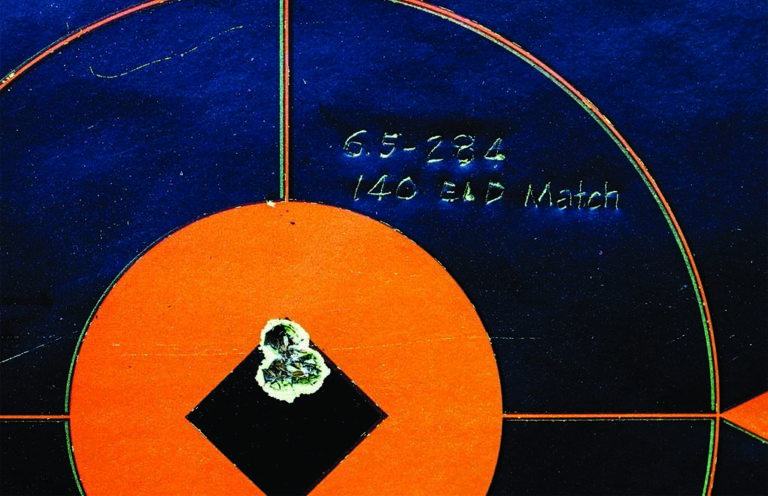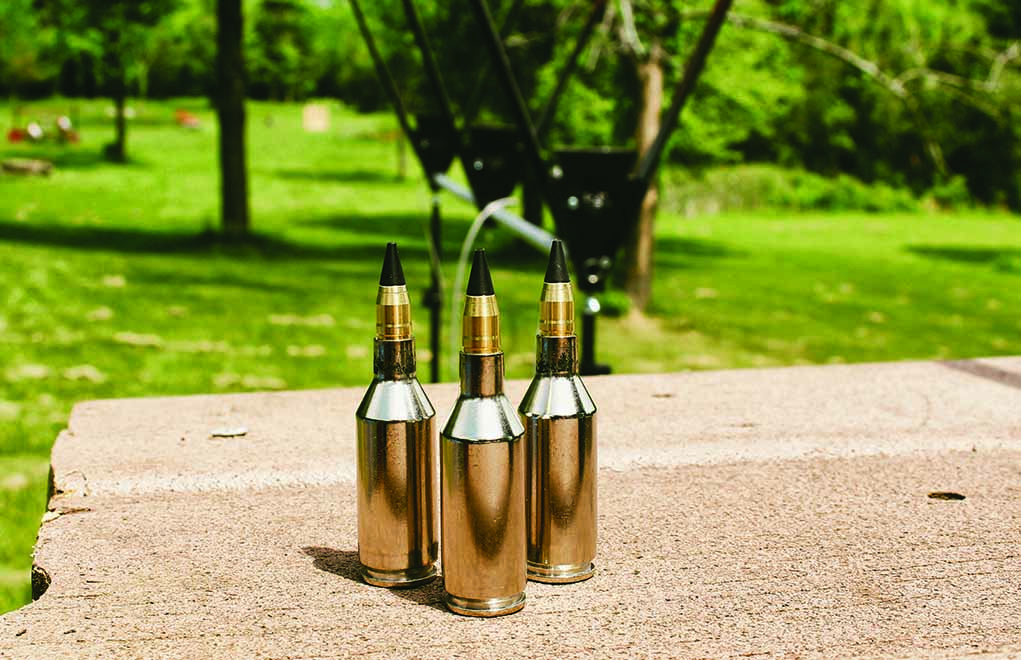

Desired muzzle velocity and downrange accuracy prove elusive goals off the reloading bench. Exactly what factors are you dealing with in the chase for each?
Accuracy in a rifle—even though “precision” is the word we actually should be using—is something every reloader is after. And, once we see a muzzle velocity figure published for a particular cartridge, there’s little others can do to drive that benchmark from the mind.
Comparing the data in several reloading manuals, you’ll find some rather wide variations in muzzle velocity figures, even for the same load. You’ll sometimes see significant differences in the maximum charge weight, as well as the velocity for that weight charge. It can be maddening, especially when you’ve chosen a particular cartridge for the velocity potential and you see numbers that are, well, disappointing.
Why does this happen? And why, when you see a target from a friend or acquaintance produce a target from a particular “recipe,” doesn’t your rifle produce a similar group?
Variables to Consider
Firstly, modern rifles are showing more-consistent results than we’ve ever seen. When I was a younger man, anyone who had a 1 MOA rifle was talked about in reverent whispers—as if they owned some mythical weapon blessed by divinity. Of course, many hunters were using iron-sighted lever-action carbines, and minute-of-pie-plate at 100 paces was “good enough.”
But, I feel modern rifles are also the best available. Inexpensive rifles are delivering groups that would have surely turned the heads of our grandfathers. We’re seeing sub-MOA guarantees on more models each year—to the point that a rifle that delivers a 2-inch group at 100 yards causes the shooter to make a face as if they’ve just taken a mouthful of sour milk.

I’m not suggesting you call off the pursuit of accuracy in your handloads once you hit the 2 MOA mark, but I am saying that not every rifle is capable of ½ MOA performance. The individuality of your barrel most definitely comes into play where group size is concerned, and there are so many variations that it sometimes seems no two are alike.
For example, my 6.5-284 Norma is a Savage rifle—from its custom shop—and it’s most definitely one of the most accurate rifles I own, giving 1/3 to ½ MOA groups out to 500 yards. However, it shows a definite preference for flat-based bullets, and I suspect the bore might be a bit “loose.” In spite of a 25-inch barrel, the velocities for this rifle are lower than expected across the board, further confirming my suspicion.
Also, consider this: I’ve seen more than one of the modern, high-BC bullets need time to settle down, giving better groups at 300 yards than at 100 yards. I suppose the bullet, like a spinning top, needs some time to obtain the perfect stability. I’ve seen this phenomenon with the longer, heavier-for-caliber bullets, such as the Nosler AccuBond, Hornady ELD-X and ELD Match, along with other similar bullets.
Target Muzzle Velocity Figures
Reaching a target muzzle velocity figure in your handloads can be equally challenging.
Taking a look at any box of ammunition, you’ll see a certain muzzle velocity listed. Is that gospel? Certainly not, because the manufacturer has no idea what type of firearm you’ll be firing that ammunition from, its barrel length or any other parameter. The same can be said for a reloading manual.

For example, the original .416 Rigby load used a 410-grain bullet at 2,350 fps for 5,000 ft-lb of muzzle energy. This has been a benchmark for comparing newly developed cartridges; and, if a cartridge doesn’t develop those velocity and energy figures, it’s generally been frowned upon.
The problem is, a ballistic pendulum and a long test barrel were used to obtain those “defining figures,” and when original ammunition for the .416 Rigby was put through a modern chronograph, the results were eye-opening. Muzzle velocities of 2,150 to 2,175 fps were observed, lowering the energy values closer to the 4,000 ft-lb mark.
Wouldn’t that make the .416 Rigby ineffective? No one ever knew the difference … certainly not the game animals.
I’ve seen some .308 Winchesters beat the muzzle velocity of the .30-06 Springfield, and I’ve seen .30-06 Springfields that can outperform some .300 Winchester Magnums. In both instances, it had to do with the particular barrel. Such is the way of the world of ballistics: There are no absolutes.
Load Up On Reloading Info:
- The Flexible And Forgiving .30-06 Springfield
- The .45 Colt: A Wheelgun Classic
- .300 Win. Mag.: The Answer To Most Hunting Questions
- Tips For Reloading the .223 Remington
Accuracy vs. Velocity
In most of my rifles, the majority of which are for hunting, I prefer to squabble over accuracy more than velocity. I’m not willing to give up a whole ton of velocity, but coming up 50 to 100 fps light isn’t going to crush me.
In my .404 Jeffery, the data indicated I should’ve been getting 2,325 fps with the particular powder charge of Reloder 15 I was using. However, no matter how hard I shook the chronograph, all I could get was 2,280 fps. It was the characteristics of my particular barrel and, with extreme spreads of 15 fps, the accuracy was certainly there, averaging ¾ MOA from the big gun.

Working with a custom 7mm Remington Magnum and 175-grain Nosler AccuBonds, I found wonderful accuracy—only to find that the muzzle velocity was slightly more than 2,500 fps instead of the 2,925 fps it should have generated. For reasons I can’t quite explain, this particular powder just didn’t get along with that rifle. Therefore, I switched powders and equaled the accuracy while reaching proper velocities.
There are many factors affecting velocity: barrel length, variations in bore diameter and the little, inexplicable “gremlins” that cause reloaders to mutter inaudible sentences.
Be sure to consider a reloading manual as a laboratory report; that is, it’s a snapshot of the performance of a certain bullet, with a certain powder charge, in the manual’s particular test barrel. This is why all the books of data suggest strongly that you start at the bottom of the charge weights and work up slowly; your rifle might develop higher pressures faster than the test barrel did.
I also recommend that you keep copious notes regarding your rifle and load development. Make note of the case brand, primer brand and type, powder charge (and perhaps even the lot number), and bullet brand and weight. If you experiment with a good number of different loads, you might start to draw your own conclusions regarding your barrel, as compared to the various test barrels.
Don’t get too hung up on it. As long as your loads do what you need them to do, the goal has been met.
Editor's Note: This article originally appeared in the February 2020 issue of Gun Digest the Magazine.

Next Step: Get your FREE Printable Target Pack
Enhance your shooting precision with our 62 MOA Targets, perfect for rifles and handguns. Crafted in collaboration with Storm Tactical for accuracy and versatility.
Subscribe to the Gun Digest email newsletter and get your downloadable target pack sent straight to your inbox. Stay updated with the latest firearms info in the industry.

![Best Concealed Carry Guns In 2025 [Field Tested] Wilson Combat EDC X9S 1](https://gundigest.com/wp-content/uploads/Wilson-Combat-EDC-X9S-1-324x160.jpg)


![Best 9mm Carbine: Affordable PCCs [Tested] Ruger Carbine Shooting](https://gundigest.com/wp-content/uploads/Ruger-Carbine-Shooting-100x70.jpg)
![Best AR-15: Top Options Available Today [Field Tested] Harrington and Richardson PSA XM177E2 feature](https://gundigest.com/wp-content/uploads/Harrington-and-Richardson-PSA-XM177E2-feature-100x70.jpg)
